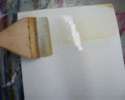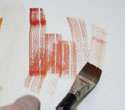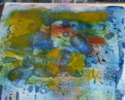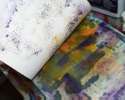Lesson 1
Lesson 2
Lesson 3
Lesson 4
Lesson 5
Lesson 6
Lesson 7
Lesson 8
Lesson 9
Lesson 10
Lesson 11
Lesson 12
Lesson
13
Lesson 14
Lesson 15
Lesson 16
Lesson 17
Lesson 18
Lesson 19
Lesson 20
Lesson 21 |
This is the third lesson of the Art Studies class by Poochie Myers.
Poochie would like to start a dialogue with new students to art as well as professionals who might want to include segments into these art lessons, or field questions from participants. Please post your comments to mailto:poochie.art@gmail.com
If you have to struggle then you are doing something wrong.
Lesson Three - Styles, Materials, Textures and More
WATERCOLOR PAINTING
Watercolor painting dates back to prehistoric times with evidence of water-based paintings from the Stone Age appearing in the caves of Lascaux, Altamira, and Ancient Arrow. Watercolor painting is fun because of its freshness and spontaneity. Today, watercolor is divided into two categories, transparent and opaque. Generally, the term watercolor refers to transparent colors, while the opaque paints are known as gouache. Acrylic paint is a watercolor type.
TRANSPARENT WATERCOLOR
Transparent watercolors are made of pigment, gum arabic, and a wetting agent, usually glycerin. They are available in tubes, which contain semimoist paint, or in pans, which contain dry cakes of paint that dissolve readily in water. Watercolors are transparent so they allow the white of the paper or a previous layer of color to show through. One of the best things about watercolor is that with the exception of a few colors that stain, it can all be removed from your painting surface so you can start over again, lift areas of color to make radiance or use the back of the paper. For special effects you can put it in a tub of water and scrub it with a brush. You can push it with a pallette knife or the other end of your brush.
GOUACHE
Gouache (possibly from the Italian word guazzo) is made like transparent watercolor but contains additives that make it opaque and slower-drying. Good-quality gouaches have great tinting strength, and with a few exceptions, these paints have a high degree of permanence. They are wonderful when used on colored papers and can be extremely attractive on black paper or black gesso coated paper.
PAPER
A good-quality, acid-free rag paper, preferably the 140-lb. (300 gsm) weight or heavier, is most suitable for watercolor work, and both sides of the sheet may be used. There are three basic watercolor paper surfaces: rough, which as the name suggests has prominent peaks and valleys (known as "tooth") and is great for stressing texture; cold-pressed, which is less textured; and hot-pressed, which is very smooth and thus ideal for ink and line work. Any paper that is suitable for watercolor is also suitable for gouache. Some of the colored papers used for pastel (such as Canson Mi-Teintes) are okay to use because of their opaqueness. Any lightweight paper must be stretched before you paint on them or else they will buckle. Just wet the paper on both sides, lay down on board of wood, plastic, metal, glass or other solid strong surface, and tape sides down all around. Let dry before you begin your painting.
MEDIUMS AND AUXILIARY PRODUCTS
Various mediums and paint-related products can be used in conjunction with watercolor paints to alter the way they perform according to your needs and to extend the range of effects you can achieve with them.
Gum arabic, an extract of a species of the acacia tree, is the binder used in watercolor paints. It can be diluted with water to make a weak solution that when added to watercolors increases their depth, transparency, and gloss.
Aquapasto, made by Winsor & Newton, is a gel composed of gum arabic and silica that can be mixed with water-based paints to achieve impasto effects.
Ox gall is a wetting agent that enhances the flow of watercolor and improves its acceptance on less absorbent surfaces. It will not increase the transparency of your paints, and should be used only in small amounts.
Winsor & Newton's Water Color Medium, a solution of acidified gum and water but should not be used with acid-sensitive pigments (such as cadmium yellow).
Glycerin retards the drying of watercolor by slowing down the evaporation of water. It is useful when you need to keep an area of a painting wet for longer than usual, but should be used only in very small amounts, since most commercial watercolor paints already contain a high proportion of glycerin.
MATERIALS, TOOLS, AND TECHNIQUES TO TRY WITH WATERCOLOR AND GOUACHE
- salt
- candle wax
- rice
- eggshells
- leaves
- seashells
- seaweed
- sand
- sandpaper
- fingers
- sponges
- polystyrene
- fiberglass
- lead pencil
- charcoal
- watercolor pencils
- china markers
- sgraffito
- razor blade
- stenciling
- spattering
- collage
|
- blending
- drybrush
- blotting
- wet-in-wet
- acrylic modeling
- paste acrylic
- gloss and matte mediums
- gesso metallic
- effect mediums
- water-based
- printing ink
- mineral spirits
- turpentine
- Liquin
- wallpaper paste
- hydrogen peroxide
- dishwashing liquid
- plastic wrap
- cellophane
- Japanese papers
- waxed paper
- tissue paper
|
Prepared Size, made by Winsor & Newton, is a glue composed of gelatin, water, and preservative and supplied as a soft gel that becomes liquid when warmed. Its purpose is to reduce the absorbency of certain grounds, including paper, boards, and lightweight textiles. If you wish to use decorative and unusual papers for watercolor, prepare the surface with size first to prevent too much absorbency and bleeding of colors.
Masking fluid, also called liquid frisket, is essentially a liquid latex preparation that is used to block out areas of work where you do not want paint to go. Some masking fluids are colorless; others are pigmented for better visibility. Apply masking fluid only to dry surfaces. To remove, simply rub it off with your finger. You can use rubber cement also. There are special masking tapes made for masking...of course, masking! You can use the edge of a stiff paper to hold the color in an area or the edge of a palette knife. You can draw on back of wax paper, leaving the wax as a resist.
LAYING A FLAT WATERCOLOR WASH
Click on images for larger view and use your browser's back button to return
 |
A good flat watercolor wash should be all one tone. Dampen your paper before starting so that no hard lines form. Mix up more paint than you think you need and, with your drawing board slightly tilted, fill your brush with color and apply the first strip across the top of the paper. Reload the brush and, working in the opposite direction, repeat the process. Continue until you have covered the entire area. You can also use stencils with this technique. |
LAYING A GRADED WASH
A graded wash shows a progressive variation in tone. Mix up a puddle of paint on your palette. Dampen your paper with clean water. Tilt your drawing board, then load your brush with color and stroke it along the top of the paper. Rinse out your brush and add a brush full of clean water to your paint mixture. Stroke this slightly lighter color on the paper. Again rinse your brush, add a brush full of clean water to the paint mixture on your palette, then stroke the progressively lighter color on your paper. Repeat this procedure until you get to the end of your page, where the color should be lightest.
MAINTAINING A SHARP EDGE
 |
To lay a soft wash against an edge that needs to remain crisp and precise, first draw the outline with a clean, damp brush, then dampen your paper up to the line and work paint into just the dampened area. You can use the edge of a stiff paper to hold the color in an area or the edge of a palette knife. |
BLENDING COLORS
To get a blended effect, dampen a sheet of watercolor paper. Lay in a strip of color to either side of the center of the paper. Then, in the center, lay in another color. The colors will bleed into each other to give a variegated effect.
Work on dry paper when you want sharp lines and on damp paper when you want softer edges.
THE DRYBRUSH TECHNIQUE
 |
This technique is favored for depicting grass and other textures, although if used too often can look gimmicky. Using a dry brush dip into the paint and apply over the area desired. Pull the dry brush across the dry watercolor paper. More of the white paper shows through when you apply less pressure to the brush. Use a combination of wet and dry for a more interesting look. |
SOFTENING COLOR WITH GLYCERlN
Glycerin extends the drying time of watercolor paints, making it possible to achieve soft-edged color. Use a painting a mixture of one part water and one part glycerin over the surface of the paper, then drop in all the colors at once. Glycerin also makes it easier to wash color off a painting and to wipe back, removing color with a tissue to reveal the white paper.
CREATING FINE LINES WITH WAXED PAPER
Put a piece of waxed paper over dry watercolor paper and, with a sharp stick, draw a pattern of lines to remain white. Then apply a watercolor wash. The wax from the waxed paper creates a resist that prevents the paint from filling in the drawn areas. Usually to remove wax it's best to use a hot iron and absorbent paper. This is one you will have to experiment with.
WORKING WITH MASKING FLUID
Masking fluid lets you mask out areas of work needing protection when color is applied in broad washes. Once the painting is dry remove the masking. You can use rubber cement too.
TURPENTINE AS A RESIST
 |
Turpentine acts as a resist when used with watercolor because watercolor and turpentine do not mix. Try different ways to apply the turpentine for different effects. |
LIQUIN AS A RESIST
Liquin, made by Winsor & Newton, is a medium used to thin oil and alkyd paints and speed their drying. Used with watercolor, however, it acts as a resist, pushing the color aside.
MONOPRINT
 |
A single print from a plate of some sort. Apply different colors of paint onto a smooth surface. Use sponges, scarffito, any method you desire to make designs in the paint. Lay the finish paper over this and smooth down. You can use a squeege or roller, depending of the different effects you choose.
Experiment with this. Use stencils, leaves, whatever. Print from the second print onto another paper. Usually the paper you want printed is laid on top of the printing plate but you make the rules! |
EXPERIMENT
 |
Choose a nice 140 lb. watercolor paper. Wet half of the paper. Paint into the wet area and then in the dry area with the same paint color. Do this with all your colors.
Try dropping color into other color. Some of these colors will push the other color away. You do need to know which of your colors will be demanding or receed. This seemingly mindless exercise can make or break your paintings. Try it, you'll enjoy it. This will show you another reason you like to paint. |
Go to Lesson 4
Review Lesson 1
Review Lesson 2 |

